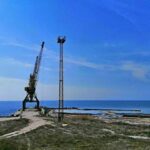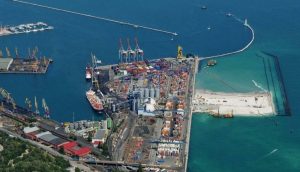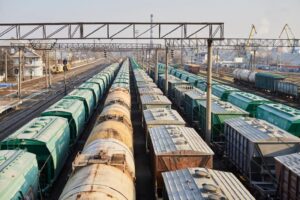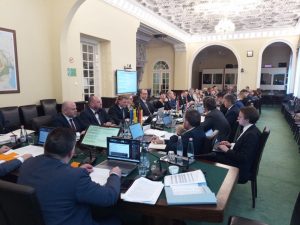The Forgotten Port of Khorly: From Foundation and Prosperity to Modernity and Decline
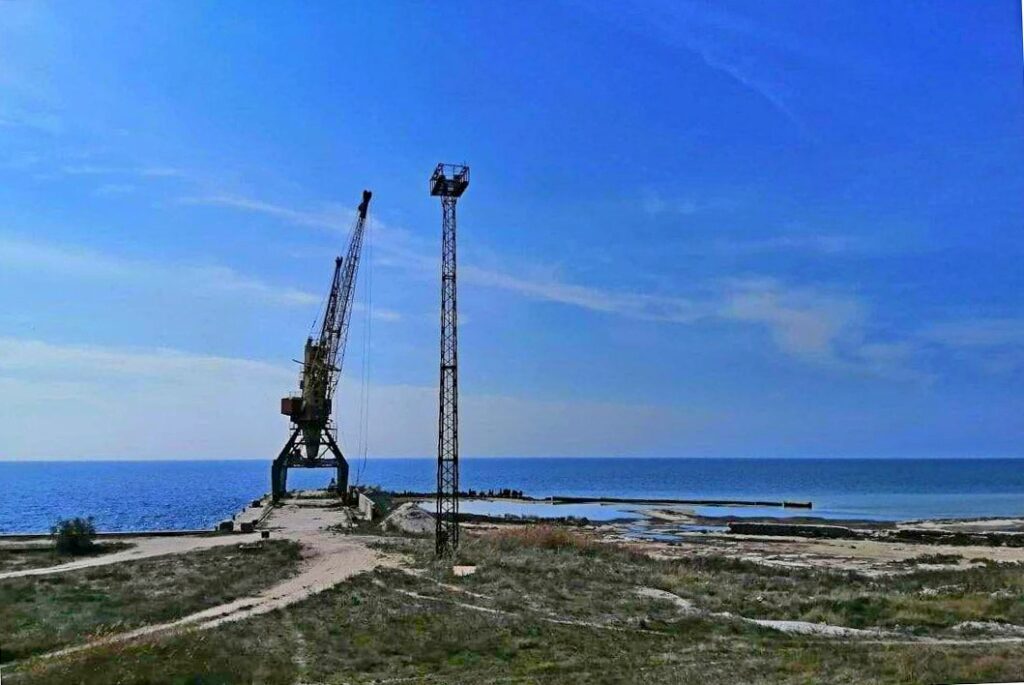
The port (now a sea trade point) of Khorly is located on the shore of the Karkinitsky Gulf of the Black Sea in the Kherson region. Once this small port had been developing successfully and even flourishing, increasing its turnover, but now the port point is abandoned and idle. And the Ukrainian Sea Ports Authority believes that its revival is not economically beneficial for the state. USM has prepared material about the history of the creation and development of the port and on the current situation in it.
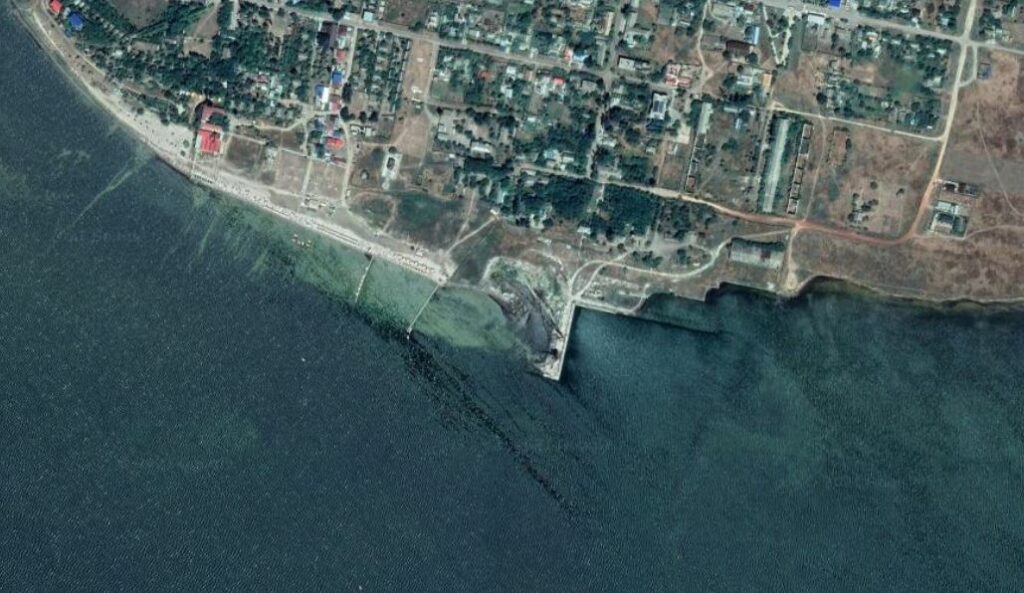
How it all began
In 1890 the landowner Sophia Falz-Fein was left a widow, and she inherited a large agrarian empire. We are talking about the Kherson region in the South of Ukraine.
The Baroness made a decision to export the products produced on her estates (Dneprovsky Uyezd, Kherson province) with the help of vessels of her own shipping company through a private ice-free seaport. An embayment in the Karkinitsky Bay matched for this purpose, the sea water in which was heated by a hot natural spring.

So, in 1897, on the shore of the bay Sofia Falz-Fein founded the village of Port-Khorly, and then began to build vessels for her own shipping company, which was named after the owner – “Sofia”. Her agency was located on the Voenny Pier in Odesa, in its southern part (place № 4) Sofia Falz-Fein’s vessels were moored.
Following the port, a customs office and a repairing basin appeared in Khorly. The project required a large investment, but almost immediately paid off and earned a solid profit.
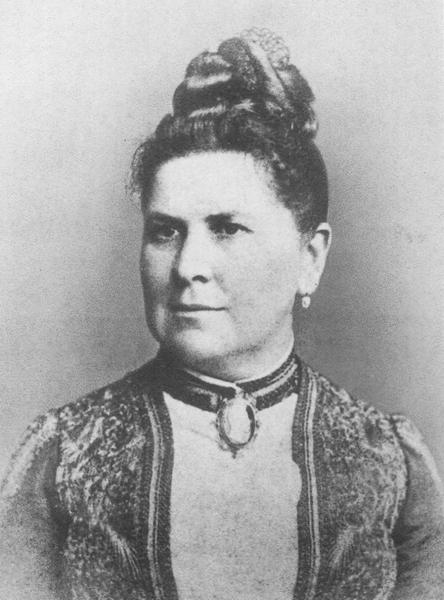
Sofia Faltz-Fein
Already in 1903, the construction of a port, a mill and a silo was completed in Port-Khorly, then up to 6 steamships could be moored to the pier at the same time. A year later, the Khorly began to play a leading role in the export trade among the ports of the Karkinitsky Bay.
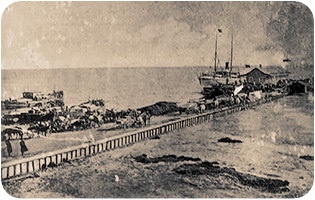
However, the low wages of dockers caused discontent; in 1905, during the unloading of a vessel with coal, dockers put forward a demand for higher wages. In response to this, a cavalry squadron of the Crimean division was brought into Khorly. Frightened by the protests, the port administration and the officials of the office of the customs post were even forced to take refuge for some time on board of an English vessel. A year later, the authorities has deployed a company of soldiers in Khorly.
Port fleet
In 1905, the landowner bought a comfortable cargo-passenger steamer, which was also named after her – “Sofia”. The vessel performed postal, goods and passenger voyages between Odesa and Khorly, sometimes with a call to Skadovsk and Ak-Mechet. Later the steamer also began to sail to Mykolaiv.
In 1907, the shipping company was replenished with one more vessel. After the fire and damages in the water area of the Odesa port, the wreck of the steamer Great Princess Olga, which was planned to be scrapped, stood for a long time. In Odesa, it was converted into a large sea barge, which became the largest of its kind on the Black Sea. With a length of 79 m, a width of 10 m and a draft of 4.2 m, the barge’s carrying capacity was 1,500 tons. Nevertheless, the barge was successfully operated with the same name on board for another 8 years. Looking ahead, with the outbreak of the First World War, the Naval Department has took it for military service, and after the end of the war, it was returned to its owner.
Another tugboat was purchased from Sweden in 1911. To accept the vessel, a team of 14 people was formed, and already in Khorly the steamer was named in honor of Sofia`s daughter – “Lydia”.
Port activities
At that time, the marketplace was actively developing in Khorly, and winter wheat, as well as rye and barley, became the main export cargo, since they were in demand abroad. The geography of trade operations expanded rapidly, and already in 1907, 36 thousand tons of cargo were shipped from the port to England, Greece, Germany, Italy and the Netherlands. After 6 years, the port’s cargo turnover has already reached 103 thousand tons. However, the volume of export operations was not always regular and often depended on demand, grain yield and, to a large extent, on competition from the Odesa, Kherson, Skadovsk and Genichesk ports. In connection with these circumstances, for example, in 1908 less than 16 thousand tons of grain were shipped from the Khorlovsky port.
With the expansion of trade operations in Khorly, a branch of the Russian Bank for Foreign Trade was opened. In the port itself, the infrastructure was developing: there were built grain storages, from where the cargo was transported in trolleys along rails to the steamers. In addition to foreign trade relations, the port received or dispatched cargo to Odesa, Kherson, Sevastopol, Mykolaiv and other points of the Black Sea basin. Grain, vegetables, fruits, building materials, steels, livestock, poultry and so on, were transported.
The port of Khorly advertised its export operations extensively. The weekly “Bulletin of Finance, Industry and Trade” systematically reported on the shipment of goods from Khorly abroad.
Permanent residents of Khorly were immigrants from different places who came here in search of work. They worked on the construction of the port, as stevedores on steamers, and during the mass shipment of grain cargo, seasonal workers from the northern part of Ukraine and the central provinces of Russia found earnings here.
The port employed an average of 300 workers each year. Note that on the eve of the First World War, 1675 people (882 men and 793 women) lived in Khorly – mostly workers.
But the First World War severely shook the position of the port. After the closure of the Black Sea straits and the termination of exports, it practically did not work, people were left without work.

Khorly ports during the USSR
At this time, the port gradually returned to its positions and continued to function actively. So, in the 20-30s, already under the USSR, the port station of Khorly of the Skadovsk port was engaged in the transshipment of sand, which was mined in coastal waters. To fulfill this task, among other things, the technical base of the port station was built and developed, namely, berth № 3 with a depth of 4.5 m, which made it possible to accomodate river-sea type vessels with a maximum deadweight of 3 thousand tons. Foreign merchant vessels started to enter the port again.
So, in 1926-1927 the port was visited by 12 foreign vessels, which has transported 31.5 thousand tons of cargo. Also, 193 coastal vessels with a cargo of 9.5 thousand tons arrived and departed from Khorly.
In 1927-1928 the port was significantly expanded, the narrow-gauge railway line destroyed during the war was restored, along which about 1.6 tons of grain were transported to vessels every day. A new reinforced concrete berth was built in the port, which ensured the simultaneous loading of two vessels. A water tower began to operate, due to which the steamers were supplied with fresh water.
In the mid-1930s, a fairway was cleared, the depth of which reached 7.2 meters, then large motor vessels with a draft of more than 5 meters began to enter the port, for example, V. I. Lenin, Red October and others. Khorly, as an ice-free port, became one of the central ports of the Kherson sea region, which received grain from the coastal and remote areas of the territory of the present Kherson region. For the successful loading of high-side vessels, an overpass with high-level berths was equipped.
Post-war time
In 1951, the port station was equipped with new portal cranes with a lifting capacity of 8 tons, which made it possible to mechanize all complex and labor-intensive technological processes.

In the 50-60s the fairway was deepened twice in the port. During this period of its history, the main cargo of the port of Khorly remained mineral and building materials, which were constantly sent to Kherson, Sevastopol, Novorossiysk, Yalta, Kerch, Theodosia. In addition, grain, wool, watermelons, vegetables were sent to various parts of the republic through the port. So, from April to June 1969, 188 vessels has visited the port. In 1971-1975 the port’s cargo turnover increased sharply, when 735.3 thousand tons were transshipped against the plan of 695 thousand tons.
In 1978, dredging works were carried out again and at the same time the approaching channel was widened from 30 to 50 meters.
Two new cranes with a lifting capacity of 5 tons each were installed here, the number of crane operators was increased – from 3 people to 12. As a result, the vessel in the port could be transshipped in just 6 hours.
The vessels of the North-Western River Shipping Company helped to carry out a large volume of cargo turnover in the port of Khorly, which completely transferred from the Baltic to the Black Sea basin for the winter period.
In 1981-1985, a new unified berthing line was built, and the volume of loading and unloading operations increased significantly.
As a result of such active development, Khorly also became a health resort village, a resort area that attracted more and more tourists.
The port’s economic stability soon deteriorated. The first blow for the port was the crisis in the 90s, but it is difficult to confirm this information: the port’s work was not covered at all, and there is practically no information about that period. After this time, the port no longer shone with high rates of cargo turnover.
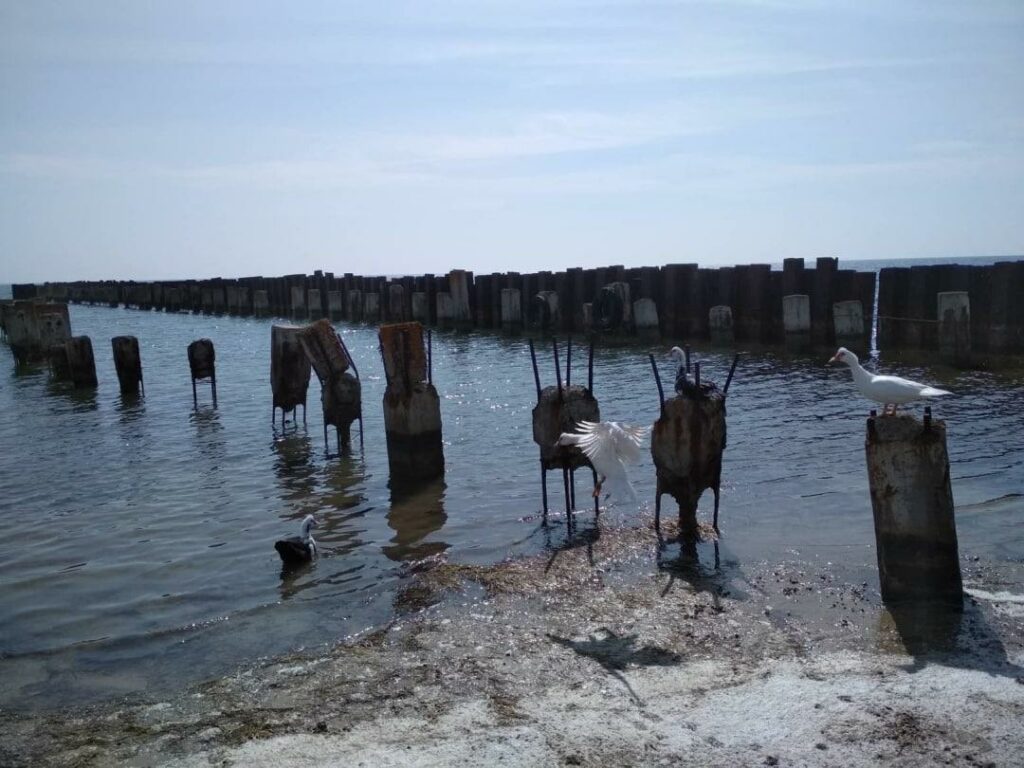
The beginning of the XXI century and decline after the annexation of Crimea
The first news about the possible revival of the port appeared already in the 2010s. In 2012, the Kherson Regional State Administration planned to restore the port with a customs checkpoint in the village of Khorly, the former Head of the Kherson customs office Armen Hayrapetyan said at the time.
In 2015, Karina Shcheglova, then director of the SE «Skadovsk Sea Commercial Port», told the CFTS portal that the Khorly port station could handle sand.
“We have a license for the extraction of sand; Crimea has always been its main consumer. After the annexation of the half island, the sale of sand was practically stopped, since it is not competitive in mainland Ukraine. At the moment, the port station is not working, but it is maintained in proper condition,” said Karina Shcheglova.
Apparently, then it was assumed that if there was an interested investor, the port would be able to handle sand again.

The situation today
Next, they refreshed memory about the port of Khorly in 2019. Then the State Enterprise “Ukrainian Sea Ports Authority” and the Ministry of Infrastructure, together with the State Property Fund, initiated a number of projects for the development of private business in the port of Skadovsk.
On the SPFU website, 5 berths were offered for rent in the port of Skadovsk and in the port station of Khorly.
It can be used to service both cargo and passenger vessels. Also, potential lease objects are the sites of the State Enterprise “Skadovsk Sea Commercial Port”, which, in combination with the berths of the Skadovsk branch of the State Enterprise “USPA”, form promising zones for the development of the port, “the SPF said.
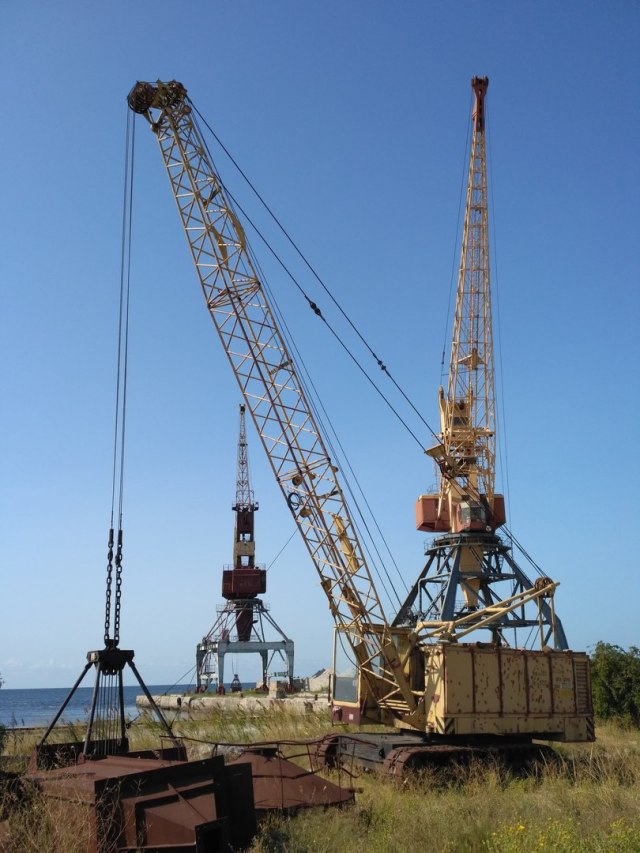
The ministry has clarified that earlier, only the port station of Khorly of the Skadovsk port provided the transshipment of about 4 million tons of sand per year. The port berths are adapted for storing cargo, carrying out export-import operations and, according to passport characteristics, can accept ro-ro class vessels.
In 2021, in reply to a request from the Kherson media in the USPA, they have answered that today the market for the sale of sea sand has been lost, because until 2014, 95% were shipped to the ports of Crimea and the Caucasus. And due to the lack of the necessary infrastructure, modern cargo (ferry transportation, grain, citrus fruits) cannot be handled in the Khorly port office. For its creation, according to the employees of the department, tens million hryvnias needed.
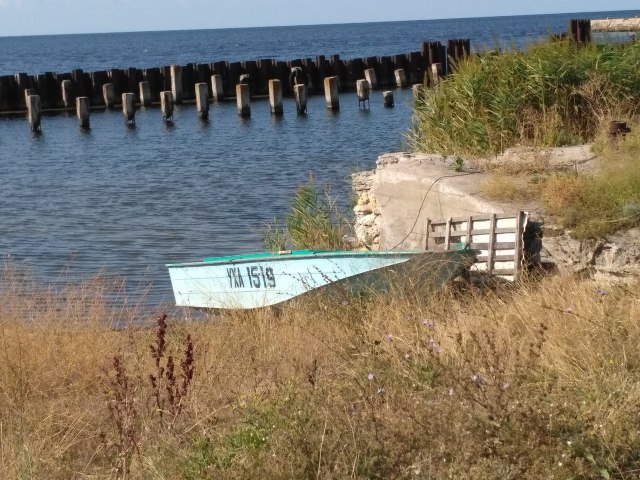
“The specialists of the USPA has carried out an analysis of the investment that needs to be engaged for the development of the Khorly port station. To do this, it is necessary to restore the berth front, as well as ensure the depth of the berth to 6 m to carry out dredging of the ship and sea channels; restore the navigation environment; restore ground infrastructure (engineering networks, communications, buildings, structures). For these purposes, it is necessary to allocate about UAH 160-175 million (USD 5.8 – 6.3 million). In addition, it is necessary to attract qualified staff to work at the port station, and most importantly, to invest efficient and reliable port operators with a promising program for the development of the cargo base,” said the USPA.
Note that, at the same time, the Administration believes that the restoration of the port point from the economical point of view is not relevant and beneficial for the state. However, given the long history of development of the port, and subject to cooperation with interested private investors, it is possible to consider the restoration and operation of the port of Khorly. The situation can turn out to be very sad for a small but quite successful port in its times. Either it will continue to remain forgotten and abandoned, since the state is unlikely to have the funds to revive it, or a private investor will be interested in it.
If we consider the second option, then anything can appear here – from a yacht club to a museum-restaurant. Or there is such an option that the investor will take the risk and invest in the revival of the port, because the experience of the past has shown that its results were indeed successful.

Olexandra Kovtutska.
